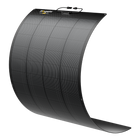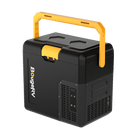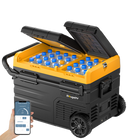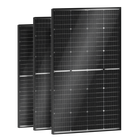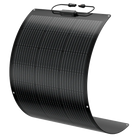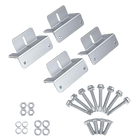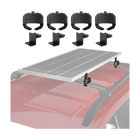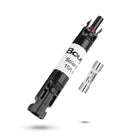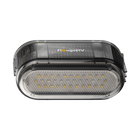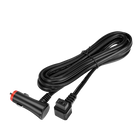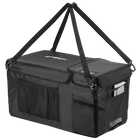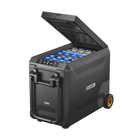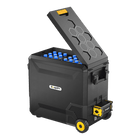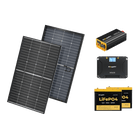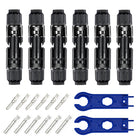How to Charge 12V Lithium-Ion Battery Efficiently and Safely?

Lithium-ion batteries have become integral to powering a wide array of devices — from laptops and smartphones to power tools and electric vehicles. Their popularity stems from their high energy density, lengthy lifespan, and minimal self-discharge rates compared to alternative battery types. Yet, lithium-ion batteries demand careful handling during charging to prevent damage or fire hazards.
In this blog post, we'll explain safe and effective methods for charging a 12V lithium-ion battery, utilizing solar panels, inverter chargers, DC-to-DC chargers, and more.
Additionally, we'll debunk common myths and answer frequently asked questions about lithium-ion battery charging. Plus, we'll share some valuable tips to help you maximize your battery's life and performance.
Let's get started!
How Can I Charge Lithium-Ion or LiFePO4 Batteries?

Lithium-ion batteries, commonly referred to as Li-ion, or more specifically LiFePO4 when discussing lithium iron phosphate varieties, are rechargeable batteries that primarily rely on lithium ions to function. Their electrochemical composition makes them particularly sensitive to temperature extremes, overcharging, and potential safety risks.
To charge lithium-ion batteries properly, it's crucial to use a compatible charger designed to supply the right voltage and current required by the battery.
There are different ways to charge lithium-ion batteries, depending on the source of power and the type of charger you have. Below are some of the most prevalent charging techniques:
Let’s explore these common methods to ensure your lithium-ion batteries are charged safely and effectively.
1. Using an Inverter Charger
An inverter charger is a useful tool when you're away from solar power options and need to charge your lithium-ion battery using grid or generator power. This device can transform alternating current (AC) from a wall outlet or generator into the direct current (DC) necessary to charge your battery.
To successfully charge a lithium-ion battery with an inverter charger, select an inverter charger that can provide the appropriate voltage and current for your battery.
Use an inverter charger that has a built-in lithium-ion battery charger function, which can optimize the charging process and protect your battery from overcharging and overheating. Look for additional protective features like temperature compensation, low voltage disconnect, and reverse polarity protection.
Here's how to proceed with the charging process:
- Connect the inverter charger to a wall outlet or a generator using the AC input cord.
- Connect the inverter charger to the battery using the positive (+) and negative (-) terminals.
- Turn on the inverter charger and select the lithium-ion battery mode on the control panel or remote control.
- Monitor the charging status on the inverter charger's display or indicator lights.
- Turn off the inverter charger and disconnect it from the wall outlet or generator when the battery is fully charged or when you need to use it.
2. Using a DC to DC Charger
A DC to DC charger is an excellent solution when you need to charge your lithium-ion battery from your vehicle's electrical system, or when you need to isolate your lithium-ion battery from your vehicle's battery to prevent draining or damaging it.
A DC to DC charger offers protection against overcharging, over-discharging, short circuits, and reverse polarity.
By converting and regulating DC power from your car battery or alternator, a DC to DC charger can tailor the charging process to meet the specific needs of your lithium batteries. It boosts the alternator's voltage to align with your battery's charging requirements and modulates the current as your battery approaches full charge.
Here’s how to use a DC to DC charger to charge a lithium-ion battery:
-
Connect the DC to DC charger to the vehicle's battery or alternator using the positive (+) and negative (-) terminals.
-
Attach the DC to DC charger to your lithium-ion battery, ensuring proper connection to the positive (+) and negative (-) terminals.
-
Start the vehicle's engine to activate the charging circuit, then turn on the DC to DC charger.
-
Keep track of the charging process via the display or indicator lights on the DC to DC charger.
-
Turn off the vehicle's engine and the DC to DC charger when the battery is fully charged.
3. Using a Solar Lithium Battery Charger
A solar lithium battery charger combines a solar panel and a lithium-ion battery charger in one unit. It’s useful when you need to charge your lithium-ion battery directly from sunlight, without any other power source.
What Voltage and Current Should a 12V, 24V, 48V Lithium Ion Battery Be Charged At?

To maximize your lithium-ion battery's lifespan and performance, it is essential to charge it at the correct voltage and current. Typically, a 12V lithium-ion battery should be charged at a voltage of 14.4-14.6V. For a 24V battery, the charging voltage should be around 28.8-29.2V, while a 48V battery requires a charging voltage between 57.6-58.4V.
The charging current is also crucial and should match the battery's capacity without exceeding its maximum charge rate – often suggested at a 0.5C to 1C rate. For example, a 100Ah battery can be charged at 50-100A.
Always refer to your battery's specifications for its precise recommended charging voltage and current levels to ensure safe and efficient charging.
Choose a Charger for a 12V Lithium-Ion Battery
The charger must be compatible with 12V lithium-ion batteries—this can be verified via the charger’s label or manual.
As mentioned earlier, it's imperative to choose a charger that can adjust its output voltage to match the battery's specific needs, ensuring neither overcharging nor undercharging occurs. Besides, the charging current should not exceed 1/10 of your battery's capacity to prevent overheating or damage.
We suggest using smart chargers as they automatically monitor and adjust the charging process based on the battery's voltage and temperature, ceasing charge when full to extend the battery's life.
Additionally, opt for chargers with safety features such as fuses, circuit breakers, LED indicators, buzzers, fans, thermal sensors, and flame-retardant materials to protect against electrical hazards and potential fires.
How to Charge a Lithium-Ion Battery Without a Charger?
Sometimes, you may find yourself in a situation where you need to charge your lithium-ion battery but you don't have access to a charger or a power source. For example, you may be camping in a remote area or traveling in a foreign country. In such cases, you may wonder if there are any alternative ways to charge your lithium-ion battery without a charger.
Here we list two methods that you can use to charge your lithium-ion battery without a charger:
Charging 12V Lithium Ion Battery With Solar Panels

To charge a 12V lithium-ion battery with solar, you need solar panels that can produce at least 14V of output voltage, a solar charge controller that can regulate the voltage and current from the solar panel to match your battery's charging requirements, and proper cables to connect them.
The solar charge controller is crucial in preventing potential overcharging and subsequent damage to your battery. This device should have a charging profile that aligns with your battery's specific chemistry and capacity. Advanced charge controllers come equipped with additional features such as temperature compensation, low voltage disconnect, and reverse polarity protection, enhancing the safety and efficiency of the charging process.
Here are the steps for charging your 12V lithium-ion battery using solar panels:
-
Connect the solar panel to the solar charge controller using the positive (+) and negative (-) terminals accordingly.
-
Link the solar charge controller to the battery, again ensuring correct attachment to the positive (+) and negative (-) terminals.
-
Place your solar panel in a sunny location.
-
Monitor the charging status on the solar charge controller's display or indicator lights.
-
Once the battery reaches full charge, or when sunlight is no longer available, disconnect the solar panel from the charge controller.
Charging 12V Lithium-Ion Battery With a Generator
A generator can also be a backup power source to charge your battery without a charger. However, charging your lithium-ion battery requires an inverter, to convert the AC power from the generator to DC power for your battery.
Additionally, your generator should have enough wattage and output voltage to charge your battery, otherwise, you may damage your battery or the generator.
Can I Charge My Lithium-Ion Batteries Using the Alternator?
Charging your lithium-ion batteries with the alternator is possible, but to do it right, you'll need a DC-to-DC charger. This device acts as a bridge, ensuring that your alternator's output matches what your lithium-ion batteries require.
Think of your alternator like a one-size-fits-all charger; it's made for lead-acid batteries and might not align with the specific needs of lithium-ion tech. Lithium-ion batteries crave a particular voltage for a full charge without risking damage.
Without a DC-to-DC charger, you risk undercharging or overcharging your lithium batteries. The DC to DC charger adjusts the alternator's juice to just the right amount, providing a safe, controlled charging environment.
So, invest in this setup if you're looking out for your lithium-ion batteries' longevity and performance, ensuring they're charged up correctly every time you hit the road.
Can I Charge a 12V Lithium Ion Battery With an Auto Charger?

Charging a 12V lithium-ion battery with an auto charger designed for lead-acid batteries is not recommended.
Auto chargers typically provide charging profiles that are not suitable for lithium-ion batteries. Lithium-ion cells require a specific constant current/constant voltage (CC/CV) charging method, which differs significantly from the bulk, absorption, and float (BAF) stages used for lead-acid types.
Using an auto charger may result in overcharging or undercharging a lithium-ion battery. Overcharging can lead to overheating, cell damage, or even dangerous scenarios such as thermal runaway, where the battery could catch fire or explode. Undercharging, on the other hand, can unbalance the cells, diminishing battery life and performance and potentially leading to irreversible damage due to over-discharging.
How Long Does It Take To Charge Lithium Batteries?
A standard lithium-ion battery can take between 1 to 3 hours to fully charge from zero. To roughly estimate the charging time, you can use this simple formula:
Charging time (hours) = Capacity (Ah) / Current (A) x 1.2
(The factor of 1.2 accounts for the inefficiency of the charging process and the tapering off of current as the battery nears full charge.)
For example, if you have a 12V lithium-ion battery with a capacity of 10 Ah and you use a charger with a current of 2 A, the estimated charging time would be:
Charging time = 10 / 2 x 1.2 = 6 hours
This is only an approximation, and actual charging times may vary depending on your battery’s condition and charger quality. The actual charging time of a 12V lithium-ion battery depends on the capacity of the battery, the current of the charger, and the state of charge of the battery.
How Long Do Rechargeable Batteries Last?

Rechargeable batteries typically last anywhere from 2 to 7 years on average. A Li-ion battery may offer around 300-500 charge cycles, and this number can be higher for high-quality cells. For example, BougeRV’s 1280Wh 100Ah LiFePO4 Battery provides 4000+ charge cycles.
To extend the life of your batteries, extreme temperatures, frequently fully discharging them (especially Li-ion), and leaving them in chargers for extended periods after they're fully charged.
To preserve the longevity of your rechargeable batteries, store them in a cool, dry place and maintain a partial charge if you won't be using them for long periods. By caring for them properly, you can ensure that your rechargeable batteries remain reliable and efficient over several years.
Lithium-Ion Battery Charging Tips
To maximize the performance and extend the lifespan of your lithium-ion (Li-ion) batteries, follow these essential charging tips:
-
Avoid Deep Discharging: It's better to recharge before your battery level drops too low. Aim to keep the charge between 20% and 80%. Unlike older battery types, Li-ion batteries don’t require deep discharge cycles.
-
Regular, Short Charges: Implementing shorter, more frequent charges can maintain the battery's health rather than waiting for it to nearly empty before recharging.
-
Keep It Cool: Heat is a major enemy of Li-ion batteries. Charge your device in a cool environment, and if possible, remove protective cases that may insulate heat during the charging process.
-
Use Compatible Chargers: Always use the original charger or one that's certified for your device. Mismatched chargers can lead to inefficient charging or even damage your battery.
-
Partial Charge for Storage: If you're storing your battery or device for an extended period, do so with the battery charged to about 50%. This state of charge is ideal for preserving battery integrity.
-
Unplug Once Charged: Although most of your modern electronic devices prevent overcharging, unplugging your device once it reaches 100% can prevent any unnecessary stress on the battery.
-
Calibrate Occasionally: While frequent full discharge cycles are not recommended, calibrating your battery every couple of months by letting it run down completely and then charging it to 100% can help maintain accurate battery level reporting.
-
Update Software: Keep your device's software updated, as updates often include optimizations for better battery management and charging efficiency.
Final Thoughts

The key to successfully charging your 12V lithium-ion battery lies in choosing the right charger, strictly following the recommended voltage and current specifications, and using reliable charging methods—whether using solar power, an inverter charger, or a DC-to-DC charger.
For more cutting-edge lithium-ion battery solutions and invaluable tips on battery maintenance, head over to BougeRV.com! Make the smart choice for your energy needs and stay powered up with confidence!
FAQs
1. Do Lithium Batteries Need a Special Charger?
Lithium batteries do require a special charger that is compatible with their specific chemistry and capacity. These batteries need higher voltage and lower current during the charging process, and they go through different stages of charging, such as constant current, constant voltage, and trickle charge. Additionally, lithium batteries have particular safety requirements to protect from overcharging, overheating, short-circuiting, and reverse polarity.
Therefore, it is essential always to use a charger specifically designed for lithium batteries. Using a regular charger not intended for lithium batteries could potentially damage the battery or cause it to explode or catch fire.
2. Can I Charge a Lithium Battery With a Normal Battery Charger?
You cannot charge a lithium battery with a normal battery charger that is not designed for lithium batteries. As explained above, lithium batteries have different charging characteristics than other types of batteries, and they require special chargers that can match their chemistry and capacity.
3. How Do I Know When a 12v Lithium-Ion Battery Is Fully Charged?
To determine when a 12V lithium-ion battery is fully charged, you can use a voltmeter to measure the voltage across the battery terminals. A fully charged 12V lithium-ion battery will typically show a voltage of around 12.6V.
Another way to know when a 12V lithium-ion battery is fully charged is to use a smart charger equipped with an indicator light or display that shows the charging status. A smart charger can sense when the battery has reached full capacity and will automatically switch to a trickle charge mode or stop charging altogether to prevent overcharging. Some smart chargers can even display the percentage of charge or the estimated remaining charging time.
4. How Do I Prevent Overcharging or Undercharging a 12v Lithium-Ion Battery?
To prevent overcharging or undercharging, you should follow these tips:
-
Use a compatible charger that matches the voltage and current rating of your battery.
-
Don’t leave your battery connected to the charger for too long after it reaches full charge. Unplug your battery from the charger as soon as possible or use a smart charger that has an auto-cut off feature.
-
If you are not going to use your battery for a while, make sure it has at least 50% charge before storing it in a cool and dry place. This will help prevent capacity loss and self-discharge.
-
Don’t expose your battery to extreme temperatures, moisture, or direct sunlight. These can affect the chemical reactions inside the battery and cause degradation or failure.





